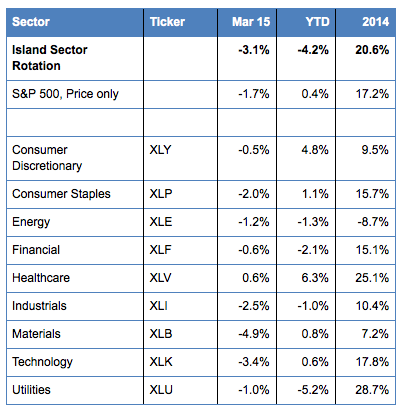 Author: Patrick Clark
Author: Patrick Clark
Covestor model: Market Neutral Growth
Disclosure: none
As disruptive as the headlines have been lately, my portfolio has been resilient, registering a monthly gain in March.
One reason for the positive performance is that unlike the vast majority of portfolios, mine is not 100% long or 100% short, but rather holds both long and short positions at all times. At the time that the tsunami stuck Japan, the portfolio had only a slight long bias. The ensuing selloff in equities had very little effect on the portfolio, since almost half of my positions profited from the move down.
This month I would like to discuss the Yen. I review about two dozen charts methodically each weekend, which allows me to see the trend changes in major currency, bond, commodity and equity markets. I look at weekly charts, meaning that each bar of the chart represents one week of price/volume action rather than one day. This chart setup shows about three years of data on each chart and gives me a focus therefore on long term trend changes. This setup also gives me a view long enough to see when action on the chart is very much out of the ordinary. The action in the Yen as represented by the ETF, CurrencyShares Japanese Yen Trust (NYSE: FXY), in March was one such case of extraordinary action. I would suggest, however, that the significance of this action going forward will go far beyond the performance of one’s investments. This action in the Yen over the next few months could predict the future of Japan as a nation.
Here’s the FXY year to date in 2011 via Google Finance:
The week after the tsunami, the volume in FXY was roughly twice its previous highest volume week over the past three years. Almost $1 billion of FXY traded during these five trading days and the currency moved up convincingly. (Source: Yahoo Finance)
The rationale for this trade was that the destruction of the tsunami would force Japanese citizens, notorious savers, to cash out of foreign-based assets, and purchase Yen to rebuild the infrastructure that was devastated by the tsunami. However, the following week, as the nuclear plant situation slowly deteriorated, the volume in FXY slowed down to previous normal levels and the price fell significantly.
What does this mean? I believe it means that the basis of the original trade is now being questioned. This price/volume action reveals the questions that are too horrible thus far for anyone to actually speak: Japan may not be rebuilt if the area is uninhabitable. There is now evidence that the soil and ground water in the area are badly contaminated and the situation is anything but contained, meaning we may not have seen the full effects.
To step away from an investor’s viewpoint and simply write as another human being who has a young child, I am worried. I do not like the story being told by Yen traders at the moment, but I cannot ignore it. I hope, of course, that Japan recovers and the damage is limited to what we have already seen, which is already devastating. I would like to see a strong uptrend in FXY.




